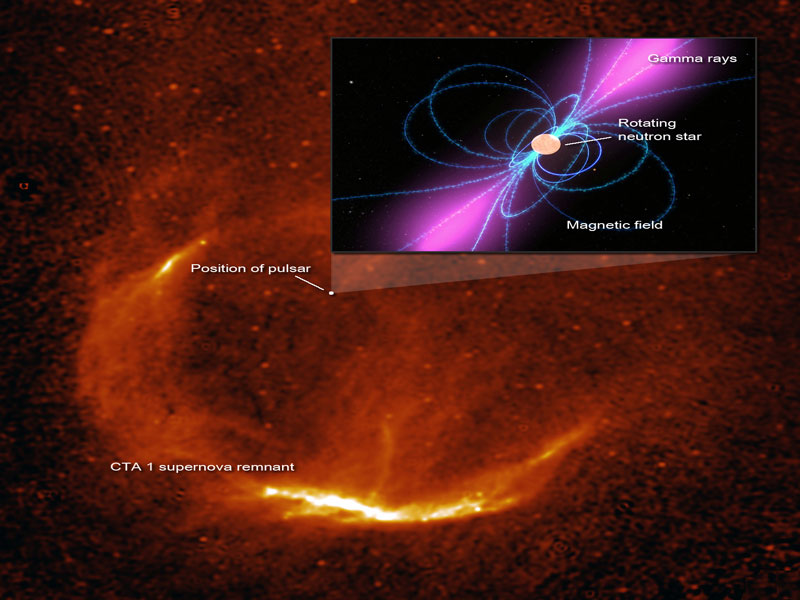APOD.pl: astronomiczne zdjęcie dnia
Codziennie nowy obraz lub zdjęcie naszego fascynującego Wszechświata
wraz
z krótkim objaśnieniem napisanym przez zawodowego astronoma.
Zobacz więcej!

Ciemmy pulsar w CTA 1
Źródło:
NASA,
S. Pineault
(DRAO)
Opis: Gdzie jest pulsar? Wcześniej pokazana mgławica CTA 1 ukazywała rozprzestrzeniającą się pozostałość supernowej, strugę i źródło punktowe, które prawdopodobnie jest pulsarem -- wirującą gwiazdą neutronową, wytwarzającą impulsy w zakresie radiowym. Nie wykryto jednak takich impulsów. Teraz uruchomiony niedawno przez NASA Teleskop Kosmiczny Fermiego (ang. Fermi Space Telescope) rozwiał tę tajemnicę przez jedne z jego pierwszych obserwacji, wskazujących, że to źródło punktowe pulsuje w promieniowaniu gamma. To dziwne źródło jest pierwszym z klasy, którą można nazwać „ciemnymi pulsarami”, wirującymi gwiazdami neutronowymi, które wydają się pulsować tylko w wysokich energiach. Takie pulsary mogą być niewykrywalne na falach radiowych lub widzialnych, jeśli emitują one te rodzaje promieniowania w wąskich, niewidzialnych z Ziemi wiązkach. Jeśli to prawda, w naszej galaktyce może znajdować się więcej pulsarów pozostałych dla Fermiego do odkrycia. Studiowanie właściwości pulsarów w zakresie gamma daje wartościowe wskazówki na temat fizyki obszarów emisji w gwiazdach neutronowych. Na powyższym rysunku pozycja pulsara jest wskazana w szerszej pozostałości supernowej CTA 1. Artystyczna ilustracja pulsara, wysyłającego wiązkę promieniowania w zakresie gamma jest pokazana we wstawce.
< | Archiwum | Nadsyłanie | Lista tematyczna | Search | Kalendarz | RSS | Edukacja | O APOD | Forum | >
Autorzy i wydawcy:
Robert Nemiroff
(MTU) &
Jerry Bonnell (UMCP)
NASA Official: Phillip Newman
Specific rights apply.
NASA Web
Privacy Policy and Important Notices
A service of:
ASD at
NASA /
GSFC
& Michigan Tech. U.